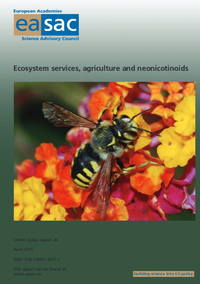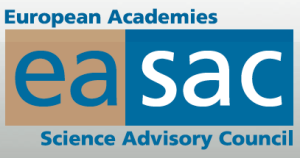
Neonicotinoides : EU Scientific Council calls for comprehensive assessment, in addition to the effects on bees
 The Scientific Council of the European Union, Norway and Switzerland, states that the focus on bees is distorting the debate on the use of neonicotinoids. According to EASAC“there are more and more evidence that the widespread use of this class of pesticides has severe effects on a wide range of organizations providing ecosystem services pollination and natural pest control, as well as on biodiversity.”
The Scientific Council of the European Union, Norway and Switzerland, states that the focus on bees is distorting the debate on the use of neonicotinoids. According to EASAC“there are more and more evidence that the widespread use of this class of pesticides has severe effects on a wide range of organizations providing ecosystem services pollination and natural pest control, as well as on biodiversity.”
The public and political attention solely on the decline of the problem of bees takes attention to the many other species that have been affected. Synthesize yet “only the protection of bees will not be enough to ensure sustainable agriculture”, and present 4 central conclusions:
1) There is a growing body of evidence that the widespread prophylactic use of neonicotinoids has severe negative effects on other organisms (no target), that provide ecosystem services, such as pollination and natural pest control;
2) There is clear scientific evidence for sub-lethal effects at very low application levels of neonicotinoids for extended periods on non-target organisms, which should be considered in the new pesticide approval procedures of the European Economic Community.
3) The current practice of prophylactic use of neonicotinoids are inconsistent with the basic principles of integrated pest management, as expressed in the Sustainable Use Policy EU Pesticides;
4) The widespread use of neonicotinoid (as well as other pesticides) restricts the potential for recovery of biodiversity in the field.
These central themes will be the subject of a full and open debate at an event in EASAC, this second. market, 13/04/15, in Brussels. The background to this discussion is the end of the use of neonicotinoids moratorium period in Europe, whose period of 2 years ending in December 2015.
Check out the full article published on the site and access the newly edited document (Ecosystem Service, Agriculture and Neonicotinoids) underlying this opinion.
Neonicotinoids: European Science Academies call for debate that expands beyond bees | 08.04.15
Source: http://www.easac.eu/home/press-releases/detail-view/article/neonicotinoi.html
A focus on honey bees has distorted the debate around neonicotinoids. But there is more and more evidence that widespread use of neonicotinoids has severe effects on a range of organisms that provide ecosystem services like pollination and natural pest control, as well as on biodiversity. These are the main conclusions of a new report published today by the European Science Academies (EASAC).
EASAC is the European Academies Science Advisory Council, a network of the national science academies of the EU Member States, Norway and Switzerland. In the wake of the Commission’s 2013 regulation restricting some uses of neonicotinoids to protect bees, EASAC assembled 13 leading experts to review the science.
Public and political attention has focused on whether honey bee colonies are being affected by neonicotinoids. But studying honey bee colony numbers does not show what is happening to the many other species providing the ecosystem services of pollination, natural pest control, soil productivity or the underpinning of biodiversity. Honey bees are just one pollinator – others include bumble bees, solitary bees, hoverflies, butterflies and moths. Other pollinators have generally declined across Europe as honey bee colony numbers have fluctuated.
In addition, honey bee colony structure provides a buffer against losses of foragers and workers, which is overlooked by many studies looking at the impact of neonicotinoid use on honey bee colony survival. In contrast, bumble bees have much less buffering capacity – and solitary bees none at all. Protecting honey bees is not enough to ensure sustainable agriculture.
In assessing the effects of neonicotinoids on non-target organisms, EASAC’s report comes to four key conclusions:
- There is an increasing body of evidence that the widespread prophylactic use of neonicotinoids has severe negative effects on non-target organisms that provide ecosystem services including pollination and natural pest control.
- There is clear scientific evidence for sub-lethal effects of very low levels of neonicotinoids over extended periods on non-target organisms, which should be addressed in EU approval procedures.
- Current practice of prophylactic usage of neonicotinoids is inconsistent with the basic principles of integrated pest management, as expressed in the EU’s Sustainable Pesticides Directive.
- Widespread use of neonicotinoids (as well as other pesticides) constrains the potential for restoring biodiversity in farmland.
Some intensive agriculture has become reliant on neonicotinoids, with proponents arguing that their withdrawal would have serious economic and food security implications. However, EASAC notes that some recent research has questioned the benefits of routine use as seed dressing against occasional or secondary pests. In some cases, neonicotinoid use has even made pest problems worse by eliminating insects which provided natural pest control.
As the EASAC report acknowledges, all pesticides involve a balancing act between the desired effect on food production and the inevitable risk of collateral damage to non-target species and the environment. In the case of the neonicotinoids, the increase in scientific knowledge over the last two years suggests that the current balance requires reassessment.
These conclusions will be discussed in an open debate with stakeholders at an EASAC event in Brussels on Monday 13 April. You can register for this event here.
Notes for Editors
Political coverage focuses very much on possible effects of neonicotinoids on honey bees, but EASAC thinks the key question should be on the effects on a range of critical ecosystem services to agriculture. These include:
– Pollination: worth 14.6 billion in Europe and where there is already a deficit (insufficient pollinators for the crops in flower) in some parts of Europe. Bees are often the most important crop pollinators but EASAC concludes that relying on a single species for pollination is not wise and restoring and maintaining pollinator diversity is very important for agriculture as well as for natural vegetation.
– Natural pest control: where predatory insects (parasitic wasps, ladybirds, some beetles, etc.) and birds consume pests sufficiently to avoid the need for chemical measures – estimated to be worth US$100 billion annually globally.
– Soil organisms and their role in protecting and enhancing agricultural productivity.
– Underpinning these services is biodiversity, which is also a policy objective in its own right under EU and global agreements.
How these services are trending was a critical question which the report notes has tended to focus on honey bees in the political debate. However, determining trends in honey bee colonies is confounded by many factors other than agricultural practice (weather, price of honey, hobby trends and so on), and colony numbers thus fluctuate a lot. To measure wider trends, EASAC looked at data on wild bee species, other pollinators, insect species with natural pest control functions and biodiversity indicators such as farmland birds. These all show major declines in recent decades.
Declines are, however, due to many factors which operate at the landscape level and the level of the individual field, as well as factors that affect individual species (such as honey bee parasites and diseases). Separating out any additional influence which arises from neonicotinoids use is thus not straightforward. EASAC looked at how the presence of neonicotinoids in a plant renders it toxic for pest insects, but also the risk that residues in pollen, nectar and other fluids may affect species not targeted and the possibility of transmission through the food chain (e.g. bees foraging on aphid honey dew, predators exposed through ingesting prey).
EASAC reviewed the scientific literature, including over 100 papers published in the last 2 years, to develop its overall assessment of the effects of neonicotinoids on non-target organisms.
EASAC is formed by the national science academies of the EU Member States, Norway and Switzerland, to collaborate in giving advice to European policy-makers. EASAC provides a means for the collective voice of European science to be heard. Through EASAC, the academies work together to provide independent, expert, evidence-based advice about the scientific aspects of European policies to those who make or influence policy within the European institutions.
The full report can be downloaded from here.
The Report’s launch on the EASAC website coincides with an article by EASAC’s Chair of the Working Group Professor Peter Neumann inNature.
Contacts
EASAC Environment Programmes Director Professor Mike Norton
michael.norton@easac.eu
Tel: +44 1763 853130
Head of EASAC Brussels Office Sofie Vanthournout
brusselsoffice@easac.eu
Tel: +32 2 550 23 32


Sorry, the comment form is closed at this time.